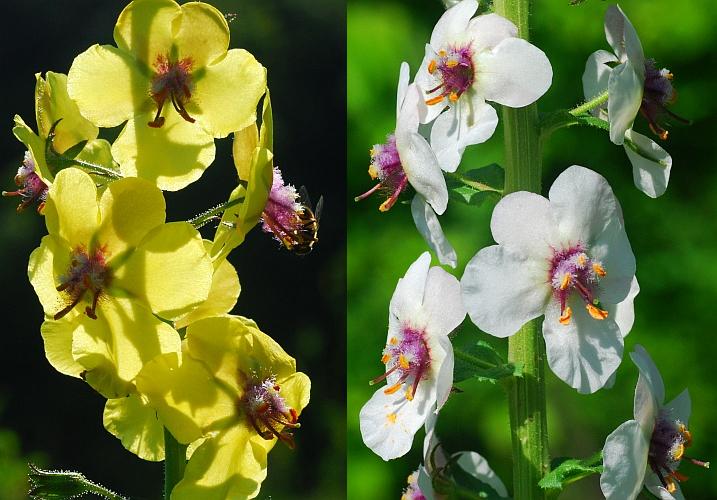Verbascum blattaria L.
Moth Mullein

Introduced
CC = *
CW = 3
MOC = 59
© SRTurner
Verbascum blattaria L.Moth Mullein | |
 |
Introduced CC = * CW = 3 MOC = 59 |
© SRTurner |
|
Family - Scrophulariaceae Habit - Taprooted biennial forb. Stems - Erect, to 1.5 m, 4-angled, sometimes branched, moderately pubescent toward the tip with unbranched, glandular hairs, often glabrous or nearly so toward the base.
Leaves - Basal and alternate, simple. Leaves of the basal rosettes 4-20 cm long, sessile or with a very short, winged petiole, the blade oblanceolate, irregularly coarsely toothed and/or scalloped to pinnately lobed. Stem leaves progressively shorter and more finely toothed or scalloped toward the stem tip, sessile, mostly lanceolate, sometimes somewhat clasping the stems, but the bases not decurrent, grading into the inflorescence bracts; leaf blades with the upper surface moderately pubescent with unbranched, glandular hairs, the undersurface glabrous. Inflorescence leaves reduced to bracts.
Inflorescences - Open racemes, the flowers solitary at the nodes, the flower stalks 8-15 mm long, glandular-hairy. Flowers subtended by foliaceous bracts.
Flowers - Calyces 5-8 mm long, the lobes narrowly elliptic-lanceolate to narrowly lanceolate, glandular-hairy. Corollas 9-15 mm long, white or yellow, with a reddish purple ring at the lobe bases, glandular-hairy. Stamens unequal, the upper 3 with the filaments shorter, straight, bearded with purplish red and usually also white hairs; the lower 2 with the filaments longer, angled downward, bearded with purplish red hairs, the anthers orange, those of the lower pair fused to the filaments from the base to about the midpoint. Ovary superior, densely glandular, subglobose, 2-locular. Placentation axile.
Fruits - Globose capsules 5-8 mm long, minutely glandular-hairy, the style base persistent as a slender, short beak. Seeds numerous, 0.6-1.0 mm long, broadly conic-quadrate in outline (truncate at each end, slightly tapered from tip to base), turgid, unwinged, the surface with thick wavy longitudinal ridges, these sometimes with cross-ridges to form a loose network, brown to dark brown.
Flowering - May - September. Habitat - Streambanks, fields, pastures, ditches, railroads, roadsides, open, disturbed areas Origin - Native to Eurasia. Other info. - This is an interesting and beautiful plant, and a splendid example of a nonagressive and well-behaved introduced species. The upper portion of the stems are densely glandular pubescent and the flowers are brilliant and intricately detailed. The densely pubescent filaments contrast with the showy corolla and make for a striking display. I always wonder why people go to garden centers to buy plants when some of the best plants are growing on the side of the road. This plant is easy to grow from seed and produces huge quantities of it. The globose fruits contain many tiny seeds each. Photographs taken off Hwy 72, Reynolds County, MO., 5-23-03, and off I-85 near Atlanta, GA., 3-20-05 (DETenaglia); also along Hwy 47, Washington County, MO, 5-25-2010, and at Don Robinson State Park, Jefferson County, MO, 7-13-2022 (SRTurner). |